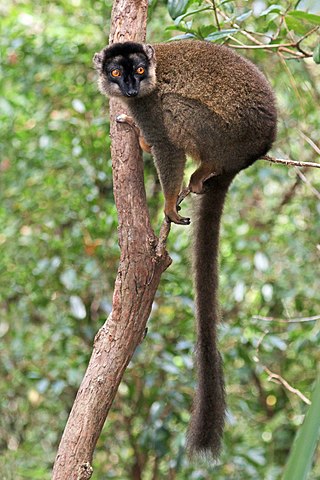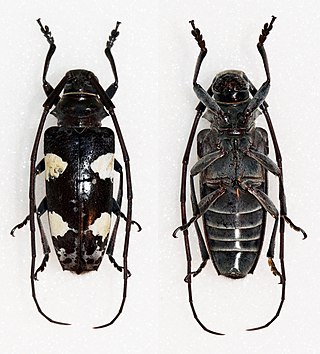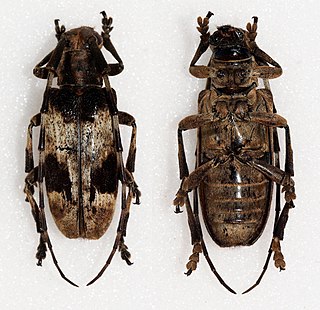
The Eurasian griffon vulture is a large Old World vulture in the bird of prey family Accipitridae. It is also known as the griffon vulture, although this term is sometimes used for the genus as a whole. It is not to be confused with the Rüppell's griffon vulture and Himalayan griffon vulture. It is closely related to the white-backed vulture.

Titus Aurelius Fulvus was a Roman senator, who was active during the reign of Domitian. Fulvus is best known as the father of Roman Emperor Antoninus Pius. His father, also named Titus Aurelius Fulvus, had also been twice consul and promoted to the patrician class.
Gnaeus Arrius Antoninus was the maternal grandfather of the Emperor Antoninus Pius.

The common brown lemur is a species of lemur in the family Lemuridae. It is found in Madagascar and has been introduced to Mayotte.
The tawny tuco-tuco is a species of burrowing rodent in the family Ctenomyidae. It is found in the desert regions of northern Chile and adjoining areas of Argentina.

The yellow ground squirrel is a large and sturdy ground squirrel species native to Afghanistan, China, Iran, Kazakhstan, Turkmenistan, Uzbekistan and Russia. It inhabits sandy steppes with Artemisia, glasswort and tamarisk.

The fulvus roundleaf bat or fulvus leaf-nosed bat is a species of bat in the family Hipposideridae. It is found in Afghanistan, Bangladesh, China, India, Myanmar, Pakistan, and Sri Lanka.
Fulvous is a colour, sometimes described as dull orange, brownish-yellow or tawny; it can also be likened to a variation of buff, beige or butterscotch. As an adjective it is used in the names of many species of birds, and occasionally other animals, to describe their appearance. It is also used as in mycology to describe fungi with greater colour specificity, specifically the pigmentation of the surface cuticle, the broken flesh and the spores en masse.
Tampoketsa Analamaitso Reserve is a wildlife reserve of Madagascar located in the Sofia Region. It covers 17 150 ha in three districts: Port Bergé, Mandritsara and Mampikony.

Blepephaeus is a genus of longhorn beetles of the subfamily Lamiinae, containing the following species:
Blepephaeus andamanicus is a species of beetle in the family Cerambycidae. It was described by Stephan von Breuning in 1935. It is known from the Andaman Islands.
Blepephaeus lemoulti is a species of beetle in the family Cerambycidae. It was described by Stephan von Breuning in 1938. It is known from Laos.
Blepephaeus higaononi is a species of beetle in the family Cerambycidae. It was described by Vives in 2009. It is known from the Philippines.

Blepephaeus irregularis is a species of beetle in the family Cerambycidae. It was described by Heller in 1915. It is known from the Philippines. It contains the varietas Blepephaeus irregularis var. alboreductus.
Blepephaeus nepalensis is a species of beetle in the family Cerambycidae. It was described by Masao Hayashi in 1981. It is known from Nepal.
Blepephaeus puae is a species of beetle in the family Cerambycidae. It was described by Lin in 2011. It is known from China.

Blepephaeus succinctor is a species of beetle in the family Cerambycidae. It was described by Louis Alexandre Auguste Chevrolat in 1852, originally under the genus Monohammus. It is known from Malaysia, India, Sumatra, Myanmar, Taiwan, China, Thailand, and Vietnam. It feeds on Acacia confusa, Albizia chinensis, Firmiana simplex, Melia azedarach, Morus alba, and Vernicia fordii.
Blepephaeus undulatus is a species of beetle in the family Cerambycidae. It was described by Maurice Pic in 1930.
Arilla was a village of ancient Lydia, inhabited during Roman times. The village was allowed to hold an annual seven-day fair in September from the year 134-135 by Titus Aurelius Fulvus Boionius, then governor of Asia.
Titus Aurelius Fulvus may refer to:







